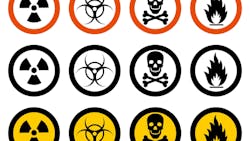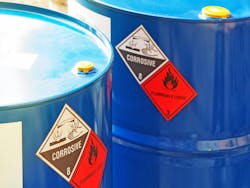How to Avoid Receiving Hazard Communication System Citations
When I think about the topic of hazard communication system (HCS) requirements, a famous quote from Strother Martin in “Cool Hand Luke” comes to mind: “What’s we’ve got here is failure to communicate.”
Violations of OSHA’s HCS requirements consistently rank among the top five, year after year, for “most citations” by type of safety category (e.g., fall protection, scaffolding, etc.). In fact, HCS often occupies the No. 2 slot.
These aren’t citations against employees for breaking the company’s rules on HCS. Rather, they are citations against the company for failing its employees when it comes to meeting HCS requirements. Notice the difference? The real shame of any OSHA citation isn’t that the company got caught; it’s that the company failed its employees.
What is HCS?
Think of HCS as an information system. The point of it is to inform employees how to protect themselves against hazards arising from the storage, handling, and use of chemicals on the job. If you were to grab a can of Solvent X off the shelf and ask a randomly selected electrician how to safely use it, what would the answer be? Doing this is a good test of whether your HCS is likely to violate OSHA regulations.
The requirements for HCS are in 29CFR 1910.1200. The fact that it’s a lot of text may contribute to the high rate of citations. But it’s also well-organized, which helps you easily understand and accurately apply it.
The first half consists of purpose, scope, and definitions [1910.1200(a), (b), and (c)]. One of the definitions is the word “workplace,” and that should give you some sense of how much (if any) of that first half you need to strain your noggin to understand. If you focus a bit, you can knock this out in five minutes.
That brings us to the meat of the HCS standard, “Written hazard communication program” [1910.1200(e)]. This is followed by:
- 1910.1200(f). Labels and other forms of warning.
- 1910.1200(g). Safety data sheets (SDSs).
- 1910.1200(h). Employee information and training.
- 1910.1200(i). Trade secrets.
- 1910.1200(j). Effective dates.
The typical administrator can ignore those last two sections, so now we’ve boiled this down to about one-third of the original material. You can’t ignore this part. Focused attention here can practically ensure your company never gets cited for an HCS violation — but to fulfill the intention of the HCS regulations, more is required.
Fulfilling the intention
It is possible to do a bit better than a “surface only compliance” job, allowing you to check off the boxes and avoid a citation. But the intention of the HCS standard isn’t that you play a box checking game with inspectors. You must communicate effectively with your employees about hazardous chemicals they may use on the job.
It is also possible to treat your HCS program as a means to protect the people in your charge — people whose families depend on them. With this mindset, instructors treat a training session as an opportunity instead of a burden, and that attitude comes across clearly. Trainees understand the training is for good reasons; that understanding is reinforced throughout each training session. The training is never “quick and dirty,” but instead is as good as it needs to be for each employee to safely deal with chemicals on the job whether a supervisor is around or not.
The main value in treating the HCS program as a means to protect your people is your employees will have a low probability of being injured by chemicals on the job. A side benefit is your company is unlikely to commit violations of the HCS regulations — and even if an OSHA inspector finds such a violation, you’ll get the benefit of the doubt.
Let’s look deeper into the four main areas where violations occur and against which citations are written.
The program
This is a document that, at a minimum, describes how the criteria for 1910.1200(f), (g), (h), and (i) will be met. You must have such a document for each workplace. The document is workplace-specific — a point that some employers overlook (and get cited for). It must include a list of the hazardous chemicals known to be present at that workplace [1910.1200(e)(1)(i)].
The product identifier referenced on the appropriate safety data sheet (SDS) must be used to identify each hazardous chemical on the aforementioned list. The list can be for the workplace, or you can have individual lists for individual work areas. If there’s a mismatch between the name used on the list and the name used on the SDSs, you’ve earned a citation (and probably confused people who read the list).
The program is meant to serve as a guide to management in making sure the company’s HCS is understood and implemented. But if an employee asks for a copy of the HCS, the employer is legally obligated to provide it [1910.1200(e)(4)].
Labels and other warnings on shipped containers
The wording is “shipped containers,” not “shipping containers,” If a spray can of Solvent X ships from the manufacturer to your distributor, it is a shipped container. Each shipped container of a hazardous nature must be labeled, tagged, or marked with six pieces of information [1910.1200(f)], which is listed below, along with where it is referenced according to OSHA:
- Product identifier [1910.1200(f)(1)].
- Signal word [1910.1200(f)(1)(ii)].
- Hazard statements [1910.1200(f)(1)(iii)].
- Pictogram(s) [1910.1200(f)(1)(iv)].
- Precautionary statements [1910.1200(f)(1)(v)].
- Name, address, and telephone number of the manufacturer, importer, or other responsible party [1910.1200(f)(1)(vi)].
Many labels today also have a QR code and a URL for the manufacturer’s website. The QR code is especially helpful because one problem with can labels is they can be difficult to read due to small text.
OSHA requires that labels be legible [1910.1200(f)(10)], and clearly the implication is that they are legible to the end-user of the product. Not all cans will have QR codes, and a URL is a bit inconvenient when you just want to know what PPE and ventilation requirements apply to the product you’re holding in your hand. A good solution here is to have the storage area well lit and provide readily available lighted handheld magnifiers.
Labels for a given product are subject to change for many reasons, so anyone using a given product should read the label on that particular can. Sometimes the product itself changes, but more often, the precautions change due to accident reports or other information from users.
Safety data sheets
The requirements for generating and using an SDS are in 1910.1200(g). Much of that text applies to manufacturers and distributors of hazardous chemicals. The main responsibility of the employer is to make the SDS for a given hazardous chemical readily accessible to employees who wish to use that chemical [1910.1200(g)(8)].
An SDS provides extensive safety information. The correct way to use the SDS is to read it before using a given chemical and ensure you can comply with all the safety requirements. SDSs have a standard format that all manufacturers must follow; this helps greatly with usability.
The SDS is divided into 16 sections. You can see what those sections are by looking at any SDS or by referencing 1910.1200(g)(1)(i) through (xvi). These include first-aid measures, handling and storage, firefighting, and disposal considerations. The four aforementioned are “understand before using” sorts of things. For example, if you need a given type of extinguishing agent, then it’s a little late to go looking for it once the chemical ignites. Have it on hand before using the chemical. This “read first” method must be SOP for all hazardous chemical users, so make it clear in your HCS and your HCS training.
In some cases, a given section of an SDS doesn’t apply to a particular chemical. This will also be indicated on the SDS. Everything not so indicated applies.
Informing and training
OSHA requires HCS training to be effective [1910.1200(h)(1)]. If you try to dog and pony show the training, you violate not just the intent of OSHA’s rule but also the rule as explicitly stated.
OSHA provides some details on what this training must cover. For example, methods and observations that may be used to detect the presence of a hazardous chemicals [1910.1200(h)(3(i)] and the measures employees can take to protect themselves [1910.1200(h)(3(iii)].
OSHA refers to its list with the words “at least,” which means do all of that — but think about how else you can make that training effective. What must you cover to ensure your employees understand and correctly implement your HCS? If you ask the hard questions here and answer them, your company will neither face hard questions from an OSHA inspector nor endure an even worse experience — trying to answer hard questions from the attorney of an employee whose death or disfigurement would have been prevented by making a solid effort to communicate to your employees about hazardous chemicals.
About the Author

Mark Lamendola
Mark is an expert in maintenance management, having racked up an impressive track record during his time working in the field. He also has extensive knowledge of, and practical expertise with, the National Electrical Code (NEC). Through his consulting business, he provides articles and training materials on electrical topics, specializing in making difficult subjects easy to understand and focusing on the practical aspects of electrical work.
Prior to starting his own business, Mark served as the Technical Editor on EC&M for six years, worked three years in nuclear maintenance, six years as a contract project engineer/project manager, three years as a systems engineer, and three years in plant maintenance management.
Mark earned an AAS degree from Rock Valley College, a BSEET from Columbia Pacific University, and an MBA from Lake Erie College. He’s also completed several related certifications over the years and even was formerly licensed as a Master Electrician. He is a Senior Member of the IEEE and past Chairman of the Kansas City Chapters of both the IEEE and the IEEE Computer Society. Mark also served as the program director for, a board member of, and webmaster of, the Midwest Chapter of the 7x24 Exchange. He has also held memberships with the following organizations: NETA, NFPA, International Association of Webmasters, and Institute of Certified Professional Managers.

